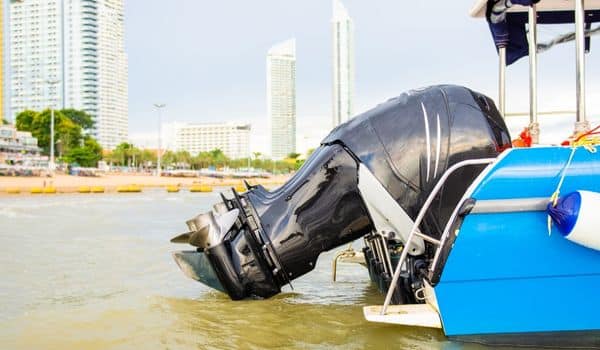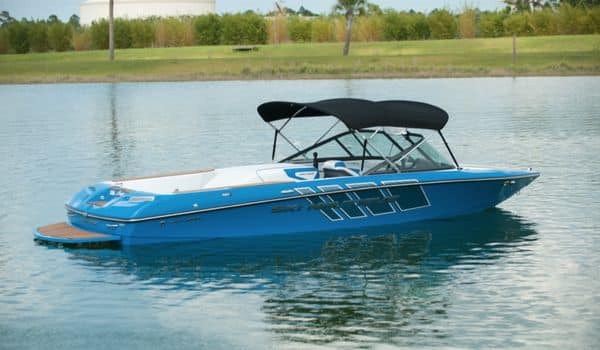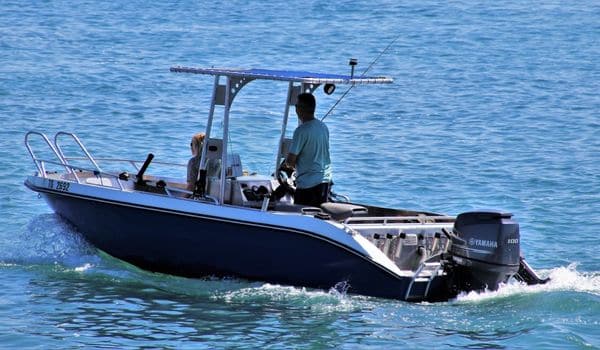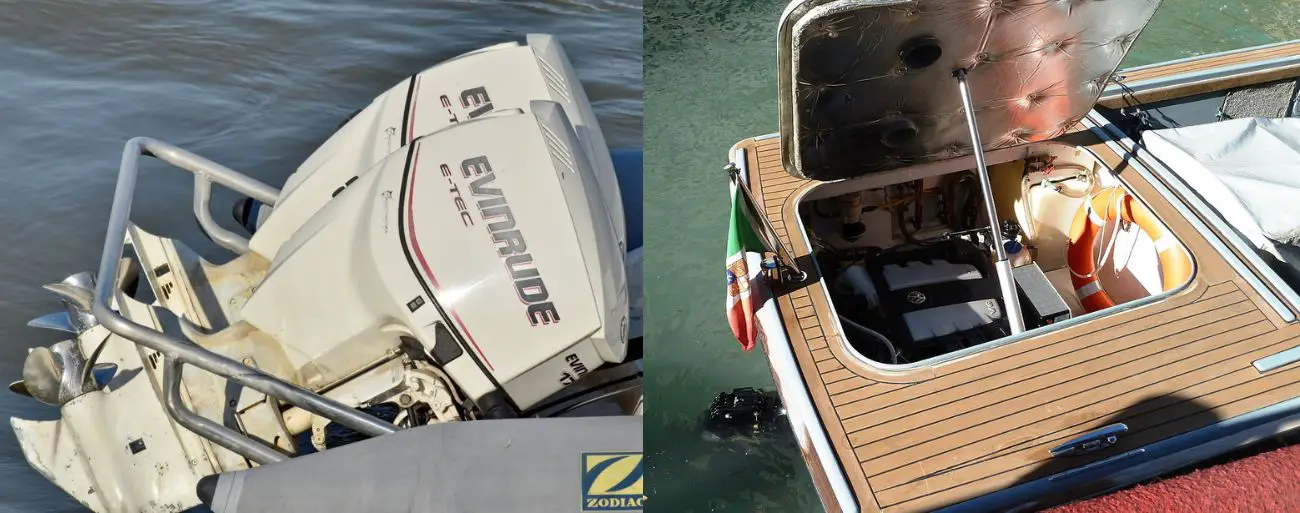An age-old debate amongst boaters is which type of motor is superior between inboard and outboard motors. While there are many different sizes, configurations, manufacturers, and models of boat motors, each camp seems to think theirs is better than the other.
In reality, it’s impossible to choose one over the other. No two boaters are the same in where they boat, how they boat, and what they are trying to accomplish on the water. After all, most of the earth is covered in water, and boats allow us to get away from the confines of land, but there’s not one boat or motor type that can do it all.
Here we’ll attempt to go over the different things you’ll need to consider to determine if either an inboard or outboard motor is best for you. We’ll go over the advantages and disadvantages of each, what types of boats use them, and which one may be more cost-effective.
Advantages of Outboard Motors

Related article: What is an Outboard Motor? (All You Need To Know)
Outboard motors have come a long way in recent years. It seems with advances in outboard technology, they’re more popular than ever. More and more boats seem to be going to the outboard route these days for a variety of reasons.
The biggest advantages of outboard motors include:
- Easier maintenance
- Lower upfront cost
- Operating in shallow water
- Portability
- Higher weight to horsepower ratio
- Better maneuverability
- Adjustable trim
- Higher potential top speeds
- The ability for more interior space
The advantages that outboard motors provide are very attractive. The portability and maintenance aspects are especially important to note in comparison to inboard motors. If you’ve been around boats for even a small amount of time, you know engine maintenance is a routine aspect of keeping your motor running smoothly.
If your outboard is having serious troubles or encounters damage that’s not possible to fix, you can simply replace it with a new one. While it’s not cheap to completely replace an outboard and should be a last resort, it is possible. Replaceability simply isn’t something you can easily achieve with inboard engines.
In addition, some boats can mount multiple outboards for additional power, and as a fail-safe, in the event one of the other engines fails. Multiple engines aren’t as easy with inboard motorboats.
Disadvantages of Outboard Motors
Outboards are not the end-all solution for boat motors. Although they’re incredibly versatile, they’re not without their limitations.
Firstly, outboards are limited by their size. They can only get so big, and you can only mount so many to one transom, so for larger vessels, it simply isn’t realistic to use an outboard.
For larger cruising vessels and yachts, inboard motors are generally the only option. Rarely will you see boats over 35 feet with outboard motors, and when they do, they have three or more in order to generate enough power.
Another major downside of outboard motors is they get in the way if you enjoy boating for watersports such as water skiing, wakeboarding, and tubing. Outboards also do a poorer job of making wakes for activities like wake surfing.
Lastly, although outboards are great at maneuvering, if you’re unaccustomed to driving a boat, the drag from the lower unit when steering can take some time to get used to. For this reason, many new boaters prefer the feeling of operating an inboard motorboat because it feels more comparable to driving a car, which most people are familiar with.
Advantages of Inboard Motors

Related article: What Is An Inboard Motor? (All You Need To Know)
Inboard motors have been around for a long time. Inboard motors, whether a standard one or a sterndrive, are a great means to provide power for many types of boats.
The biggest selling points for inboard motors include:
- Best suited for watersports
- Allow for the use of a swim platform
- Quieter operation (if muffled correctly)
- Higher torque
- Can last longer (especially diesel engines)
There are some situations where an inboard motor will be necessary. The most common situations where inboard motors excel are when used for watersports, or for larger boats.
While inboard motors have many uses, and there are a handful of good reasons to use one over an outboard, they are far from perfect.
Disadvantages of Inboard Motors
Inboard motors have lost popularity for several reasons. While they have fallen out of favor mostly because of the performance improvements of modern outboards, their biggest drawback relates to maintenance.
Even the most routine maintenance that’s required for inboard motors is generally regarded as labor intensive. This is because inboards are in the interior of the boat, which makes them hard to access in most cases.
Add the fact that inboards are not easily portable or replaceable, and you’ve got a significant upkeep disadvantage over outboard motors.
Some additional disadvantages to inboard motors include a higher upfront cost, they can limit cabin and seating space, and they can be less maneuverable.
Lastly, inboard motors may not be the best option if you plan to operate your boat in shallow water because standard inboards don’t have the ability to adjust the trim level to raise the prop up. However, this issue is remedied if you opt for a stern drive motor, also known as an inboard/outboard motor.
What boat types will require outboard motors?

Although there are many types of boats that can use either an outboard or inboard engine, some boats are limited to one or the other.
Some examples of boats that either require or it makes the most sense to use an outboard include:
- Center console boats
- Small aluminum boats
- Skiffs
- Pontoon boats
- Bass boats
- Inflatable boats
The types of boats that require an outboard are either too small to house an inboard motor, or they’re designed with a fixed transom that’s intended to mount an outboard motor.
If you have your eye on a certain style or type of boat, the question of whether you should use an inboard or outboard motor may already be decided for you.
What boat types will require inboard motors?

As mentioned earlier, outboards have a ceiling for the size of the boat they can accommodate. Due to their higher torque capabilities, inboard motors are required for larger cursing vessels and yachts.
Other common boat types that use inboard engines include:
- Bowriders
- Cigarette boats
- Cuddy cabins
- Wakeboard/ski boats
- Cabin cruisers
The most common type of small recreational boats that use inboard engines are wakeboarding/ski boats, as mentioned previously.
Inboard motors are more or less a requirement for watersports because outboard motors get in the way of tow ropes and don’t produce the kinds of wakes necessary for wake surfing for example.
A significant majority of recreational boaters engage in boating to pleasure cruise and engage in watersports with their friends in family. Chances are if you’re reading this, you fall into that group. If your primary purpose for purchasing a boat is for pleasure cruising and watersports, you can’t go wrong with a boat that’s equipped with an inboard engine.
Which boat motor type is more expensive?
Boat ownership costs money, it’s just a simple fact. Along with the costs of the initial purchase of the boat, you’ll have reoccurring expenses such as maintenance, fuel, repairs, upgrades, storage, winterizing, and the list goes on.
There’s a reason the saying “the only thing better than having a boat is having a friend with a boat” rings true. Although boats require a significant time and financial investment, the fun and memories that go along with time on the water are priceless.
It’s not so simple to say whether inboard or outboard motors are more expensive. How much they cost to purchase and maintain will boil down to how big they are, whether new or used, and the brand.
However, in general, outboard motors are less expensive overall compared to inboard motors. This is because outboard motors can be acquired for a lower upfront cost and because the maintenance is less labor intensive, it’s less expensive as a result.
Modern outboard motors are also generally accepted to be more reliable as well as they seem to be able to last just as long as inboards while requiring less maintenance along the way. However, older outboards may not last as long as inboards from their time period.
Inboards are also more maintenance-heavy because of their inability to be easily replaced, extensive repairs are needed. Inboard motors are often used for long periods of time, only surviving because of frequent repairs. This constant cycle of replacing parts and repairing a worn-out inboard will simply cost more money in the long run.
Conclusion
There are many factors that go into selecting the right boat motor. Things like your intended use, where you plan to boat, and how big the boat you want are all things you’ll have to consider.
Boat engines are one of those things where one size does not fit all. One person may have a completely different set of needs than another, so one type of boat and motor won’t suffice for both.
Whether the type of boat you want dictates your motor choice, or you need to decide on what engine is best for you before you decide on a type of boat, this guide should be able to help you sift through the noise and decide on a motor that’s specific to you and your needs and goals.
- What Is The Cheapest Way To Store A Boat? - February 28, 2023
- Do Boats Need Bottom Paint? (Uncovering the Truth) - February 2, 2023
- How Much Is Bass Boat Insurance? (Real Quotes) - January 18, 2023

